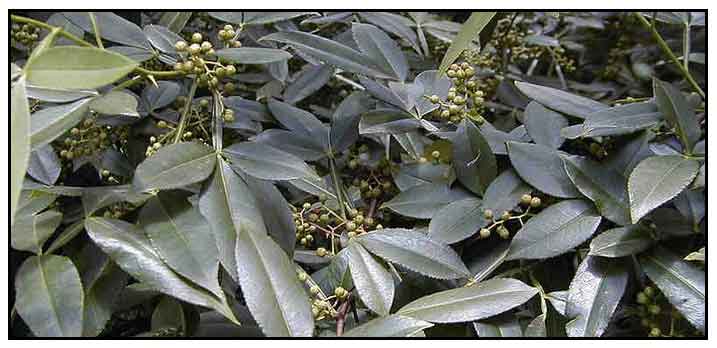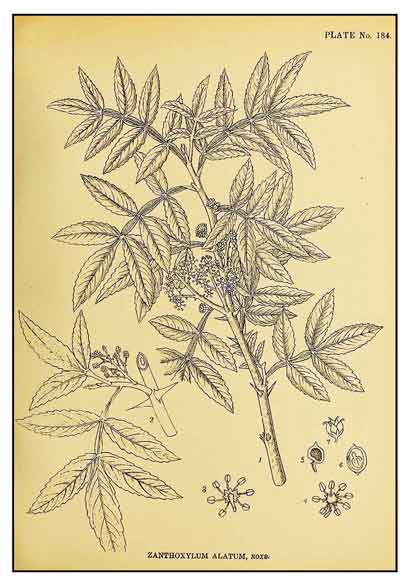 Botany Botany
Chi-it is a shrub or small tree, almost entirely smooth, with a strong aromatic smell. Bark is corky, with conspicuous young stems with thick conical prickles raising rising from a corky base. Spines are shining and sharp, growing on branchlets. Leaves are alternate, usually with 2 to 6 pairs of leaflets. Petioles and rachis are narrowly winged. Leaflets are elliptic-lanceolate, 2 to 8 centimeters long and 1 to 1.8 centimeters wide. Flowers are small, yellow, usually unisexual, borne in dense lateral panicles. Fruit is usually a solitary carpel dehiscing ventrally, about 3 millimeters in diameter, tubercled, red, and strongly aromatic.
 Distribution Distribution
- Only in the Benguet areas, in thickets about limestone cliffs and boulders, at an altitude of 1,300 to 1,500 meters.
- Also occurs in India to southeastern China.
Constituents
- Bark yields a bitter crystalline principle, identical to berberine, and a volatile oil and resin. The carpels yield a volatile oil, resin, a yellow acid principle, and a crystalline solid body, xanthoxylin.
- Carpels of the fruit yield an essential oil which is isomeric with turpentine and like eucalyptus oil in odor and properties.
- The bark contains berberine.
- The essential oil from the seeds consists entirely - over 85% - of the hydrocarbon 1-a-phellandrene and also a small quantity of linalool and an unidentified sesquiterpene.
- Bark yields active compounds: alkaloids (g-fagarine, b-fagarine, magnoflorine, laurifoline, nitidine, chelerythrine, tambetarine and cadicine), coumarins (xanthyletin, zanthoxyletin, alloxanthyletin), and resin, tannin and volatile oil.
- Essential oil study by GC-MS yielded 39.21% oxygenated compounds. Monoterpenes and sesquiterpenes were 47.33% and 10.83% respectively, alcohol percentage was 26.76%, and 15-hexadecanoloide, 6.58%, was the only cyclic ester in relatively high percentage.
(10)
- Essential oil of leaves yielded fourteen components with the main components identified as linalool (30.58%), 2-decanone (20.85%), β-fenchol (9.43%), 2-tridecanone (8.86%), β-phellandrene (5.99%), Sabinene (4.82%), and α-pinene (4.11%). (See study below) (16)
- Studies of various plant parts i.e., seed, leaves, fruit, root, and bark have yielded alkaloids, flavonoids, saponin, tannins, steroids, terpenes, glycosides, carbohydrates, phenolic proteins, essential oil, and amino acids viz., arginine, aspartic and glutamic acid, glycine, histidine, threonine, tyrosine. (25)
- The bark yields alkaloids viz., g-fagarine, b-fagarine, (skimmianine), magnoflorine, nitidine, chelerythrine, tambatarine). Bark also yielded a bitter crystalline principle i.e., berberine. Volatile oil yield consisted mainly of linalool, ß-sitosterol, and its glucoside, tamblin and tambulatin, aramatamide, lignans, asarinin and fragesin, α- and ß-amyrinslupeol and ß-sitosterol ß-D-glycoside. (25)
- GC-MS analysis of hexane extract of fruits yielded 36 chemical compounds including
eucalyptol, linalool, quercivorol, menthoglycol, trans-pipertiol, carveole, exo-2-hydroxy-1,8-cineole,theaspirane, piperitone, cuminol, artimisia alcohol, caryophyllene, α –Asarone, β- Asarone, 2-hydroxy cylclopenta decanone, palmitic acid, palmitic acid methyl ester, among others. (28)
- Methanol extract of fruits yielded alkaloids, glycosides, carbohydrates, tannins and phenolic compounds, flavonoids, steroids, fixed oils and fats, with absence of saponins, proteins and amino acids, and gums and mucilage. HPLC chromatography for bioactive principles identified a flavonoid (R1=2.8) and anthraquinone (R1=2.2). (30)
- GC-MS analysis of leaves for essential oil yielded 34 chemical constituents. Major constituents were beta-linalool (53.05%), bergamot mint oil (12.73%), alpha-limonene diepoxide (11.39%), alpha-pinene (4.08%), beta-myrcene (3.69%), and D-limonene (3.10%). (see study below) (31)
- Study of bark of Z. armatum isolated a new amide, armatamide (1), along with two lignans, asarinin and fargesin,
α- and ß-amyrins, lupeol, and ß-sitosterol-ß-D-glucoside. (32)
Properties
- Fruit considered antiseptic, carminative, disinfectant, deodorant, stomachic.
- Leaves and fruit as carminative, sudorific, emmenagogue and astringent.
- Studies have shown antifungal, insect repellent, hepatoprotective, larvicidal, spasmolytic, anti-inflammatory, antipyretic, antioxidant, CNS stimulant, trypanocidal properties.
Parts used
Bark, seeds, fruits, leaves.
- Fruits, bark, and leaves are used as spice in the Indian medicine system.
Uses
Culinary
- In China, India and Pakistan, fruit used as condiment.
- Fruits
Folkloric
- Decoction or infusion of bark and seeds used as an aromatic tonic in fevers, dyspepsia, and cholera.
- Fruit, as well as the branches and thorns, used as a remedy for toothache; also, as carminative and stomachic.
- Elsewhere, used for asthma, bronchitis, cholera, fever, indigestion, toothaches, varicose veins and rheumatism.
- Sino-Annamites use the leaves and fruits as carminative, sudorific, emmenagogue, and astringent..
- In Indian system of medicine, used as stomachic, carminative, and anthelmintic. Fruits and seeds used as aromatic tonic in fever, dyspepsia and cholera.
Studies
• Phenolic Constituents: Study isolated two new phenolic constituents from the seeds - 3-methoxy-11-hydroxy-6,8-dimethylcarboxylate biphenyl and 3,5,6,7-tetrahydroxy-3',4'-dimethoxyflavone-5-β-d-xylopyranoside along with five known compounds.
• Antifungal / Insect Repellent: Essential oil of the fruits of ZA showed repellent activity against insect Allacophora foveicollis and fungistatic activity against 24 fungi, including aflatoxin-producing strains of A flavus and A parasiticus.(3)
• Hepatoprotective: Study of the ethanolic extract of leaves of Z armatum on CCl4-induced hepatotoxicity in rats showed significant decrease in liver enzymes and liver inflammation, supported by histopath studies on the liver. Results exhibited significant hepatoprotective activity. (4)
• Insecticidal / Repellent Activity: Study of the essential oil of Zanthoxylum armatum showed high and rapid poison activity on Aedes albopictus and Culex quinquefasciatus, showing a potential as natural insecticides against mosquitoes. (5)
• Essential Oil / Larvicidal: Study of essential oil yielded at least 28 compounds, consisting mainly of oxygenated monoterpenes and monoterpenes. The larvae of three mosquito species - A. aegypti, A. stephensi, and C. quinquefasciatus - were susceptible to the essential oil composition and presents a potential for the development of alternative plant based larvicides. (6)
• Spasmolytic / GI, Respiratory and Cardiovascular Effects: Crude extract of ZA caused concentration-dependent relaxation of spontaneous and high K+ induced contractions in isolated rabbit jejunum. Results showed Zanthoxylum armatum exhibits spasmolytic effects, mediated possibly through Ca++ antagonistic mechanism, which provides pharmacologic base for its medicinal use in the gastrointestinal, respiratory, and cardiovascular disorders. (7)
• Leaves / Essential Oil: Study of the volatile constituents from leaves essential oil yielded twenty-three components (99.5% of the oil). Major classes of compounds consisted of non-terpenic acyclic ketones, with 2-undecanone (65.6%) as the major constituent. 2-undecanone can be commercially exploited for perfumery and flavoring applications. (11)
• Anti-Inflammatory / Fruit: Study evaluated a methanolic fruit extract for anti-inflammatory activity in Wistar rats. Results showed significant inhibition of carrageenan-induced paw edema. (12)
• Antipyretic / CNS Stimulant Effect / Roots: Study of petroleum ether and ethanolic extract of roots showed antipyretic and CNS stimulant effect. (13)
• Alkaloids / Stem Bark / Anti-Inflammatory: Study evaluated an aqueous extract of stem bark in acute and chronic models of inflammation in Wistar rats. An alkaloid fraction was found to be more effective compared to flavonoid in carrageenen-induced inflammation model. (14)
• Anthelmintic / Seeds: Various extracts of Zanthoxylum armatum was tested against adult Indian earthworms Pheretima posthuma as test worms. Results showed the aqueous extracts with greater potency compared to other extracts, taking less time to cause paralysis and deaths of the earthworms. (15)
• Antimicrobial / Antioxidant / Seed Essential Oil: Essential oil and ethanolic extract exhibited potent antifungal activity against A. alternata, A. brassicae, and C. lunata and significant antibacterial activity against B. subtilis, M. luteus, S. aureus, and E. coli. In addition, further testing demonstrated antioxidant compounds. (16)
• Antioxidant / Fruit: Study evaluated the antioxidant activity of Z. alatum whole fruit by various in vitro assays. Results showed ethanolic extracts to contain large amounts of flavonoids and phenolic compounds, exhibiting high antioxidant and free radical scavenging activities. The extracts also chelate iron and showed reducing power. The fruit extract showed a potential natural source of antioxidants. Â (18)
• Ingredient in Anti-Psoriasis Cream Formulation: A cream formulation for the treatment of psoriasis was composed of Zanthoxylum alatum, Boswellia serrata, 18-beta glycerrhetinic acid, 7-dehydrocholesterol, vitamin E and an extract from fertilized Zebrafish eggs. The extract of Z. alatum was used for its properties against itching due to the active moiety (alkamides: hydroxy-alpha/beta/gamma-sanshools). (20)
• Seed Essential Oil / Source of Linalool: The seeds of Zanthoxylum alatum yielded 1.5% of oil (v/w), and 56 constituents, representing 99.5% of the oil. Major components were linalool (71%), limonene (8.2%), β-phellandrene (5.7%) and (Z)-methylcinnamate (4.9%). Results suggest the seed can be a commercial source for the isolation of linalool. (21)
• Trypanocidal Activity: Methanolic extract of Zanthoxylum alatum leaves and Eugenia caryophyllata fruits were tested against trypanosma evansi for trypanocidal activity. Results showed trypanocidal activity with decrease in trypanosome counts in a concentration- and time-dependent manner. (22)
• Antimicrobial / Cytotoxic / Insecticidal / Anti-Leishmanial / Fruits: A crude extract of Z. armatum showed 86 ± 10% antifungal activity against Trichophyton longifusis while n-hexane, chloroform, and aqueous-methanol fractions inhibited the pathogen by 90. 85. and 70% respectively. Crude ethanol extract and chloroform and aqueous-methanol fractions exhibited significant toxicity on Brine shrimp lethality assay with LC50 of 6.66 ± 1.1, 21.4 ± 3.3, and 29.6 ±± 3.9 µg/ml, respectively. Study showed tested fruit extracts and fractions showed strong antifungal, cytotoxic, phytotoxic, insecticidal and anti-leishmanial effects. (24)
• Antidiabetic / Lipid Effects / Bark:A hydro-methanolic extract of bark of Zanthoxylum armatum was evaluated for anti-diabetic activity in STZ-induced diabetic rats. Glibenclamide was used as standard. Results showed significant reduction in blood glucose, total cholesterol, and triglycerides, LDL, VLDL along with a significant increase in HDL. (25)
• Anticancer
/ Stem Bark: Study (Mukhija et al) evaluated ethyl acetate extract of stem bark of Z. alatum for cytotoxic and antioxidant potential. Cytotoxicity was studied using various cancerous cell using MTT assay. Extract showed significant cytotoxic potential on lung and pancreatic cell lines. Activity was attributed to flavonoids isolated from the extract. (25)
• Hypoglycemic / Hypolipidemic / Fruit, Bark, and Leaves: Extracts of fruit, bark, and leaf from Z. armatum were evaluated for α-glucosidase inhibitory activity in alloxan induced diabetic mice. Leaves and bark extracts showed maximum α-glucosidase inhibition (96.61 ± 2.13 and 93.58 ± 2.31%, respectively). The extracts showed hypolipidemic effect by reducing LDL level. Results suggest Z. armatum extracts showed excellent antidiabetic potential in vivo and in vitro and can be considered for further clinical assessment and drug development. (26)
• Proximate Analysis / Toxic Metal Contents / Leaves, Bark and Fruit: Study evaluated the elemental contents and proximate analysis of leaves, bark and fruit of Z. armatum. Lead (Pb), manganese (Mn), zinc (Zn), cobalt (Co), chromium (Cr), copper (Co), iron (Fe), nickel (Ni), potassium (K), and sodium (Na) were detected in the leaves, stem bark and fruit but were within established limits, proving the plant is free from toxic level of heavy metals. The presence of Zn, Mn, and Cr justify the hypoglycemic potential of the plant. Nutritional analysis yielded carbohydrates, proteins, fats, and crude fiber in sufficient amounts. Results suggest a potential source for various formulations as medicinal and nutritional supplements. (27)
• Antimicrobial / Bark: Study evaluated the antimicrobial efficacy chloroform, methanol, and acetone extracts of Z. armatum bark against four different microorganisms viz. Staphylococcus aureus, Escherichia coli, Proteus vulgaris and Pseudomonas aeruginosa. Overall, the methanol and acetone extract of bark showed to be more effective for S. aureus and the chloroform extract for P. vulgaris. (29)
• Antispasmodic / Antifungal / Essential Oil / Leaves: GC-MS analysis of leaves for essential oil yielded 34 chemical constituents. The EO from Z. armatum showed significant antispasmodic effect and relaxed the isolated rabbit jejunum in spontaneous as well as KCl-induced contraction. Study also showed antifungal activity with maximum effect against M. canis, C. albicans, and C. glabrata with % activity of 84.87, 83, and 79, resspectively. The EO also showed cytotoxic and phytotoxic potential. (see constituents above) (31)
• Antioxidant / Cytotoxic / Leaves: Study evaluated various extracts (methanol, chloroform, petroleum ether) of Z. alatum leaves for antioxidant and cytotoxic activity. Antioxidant activity was measured in vitro with standard methods like DPPH, superoxide anions, NO, OH radical and reductive assay. Cytotoxicity was measured using Ehrlich Ascites Cancer (EAC) cells. The extracts exhibited dose dependent antioxidant activity. Among the three extracts, the methanol extract showed better dose dependent antioxidant and cytotoxic activity. (33)
Availability
Wild-crafted.
|

![]()




 Distribution
Distribution